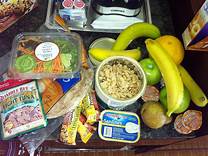Importance of well balance diet
All food contains all of the nutrients we need to be healthy, it is necessary to eat various foods in sufficient amounts. A good diet will include many different foods, and sufficient in quantity and quality to meet an individual’s need for food energy and other micro nutrients.
CEREALS
Typical serving size:
1 cup (8 oz or 226 g), but varies by type and productHOW THEY HARM
High in salt, sugar, or fatWHAT THEY HEAL
Heart disease Cancer Constipation Weight gain CEREAL FACTSJohn Harvey Kellogg, the medical director of the Battle Creek Sanitarium (a health institute) and his brother Will invented a wheat-flake cereal to improve bowel function
W
Post, one of Dr
Kellogg’s patients, invented a wheat and barley mixture that he called Grape Nut Flakes in 1897
Food companies founded by the Kellogg brothers and Post remain North America’s leading producers of cold cereals, with dozens of different brands
Cereals are one of the most popular members of the complex carbohydrate, or starch, food group
More than 90% of all commercial cereals are enriched or fortified with various vitamins and minerals, especially iron, niacin, thiamine, vitamin B6, and folic acid
Regulations about adding nutrients to cereals differ in the U
S
and Canada
Wheat, corn, rice, and oats are the most familiar grains used to make cereals
Most flaked cereals are varying combinations of flour, water, sugar, and salt that are mixed into a dough, rolled thin, and then toasted
Served hot or cold, cereals can be a healthful, low-calorie breakfast
But be sure to read the label and minimize added sugar, sodium, preservatives, and other additives
Health Benefits
Helps prevent heart diseaseOat cereals are high in soluble fiber that helps lower blood cholesterol levels, thereby reducing the risk of heart disease
May help prevent cancer
Some cereals, especially those made from whole grains or with added bran, are high in insoluble fiber
These help prevent constipation and may also reduce the risk of some cancers, including colon cancer
Helps reduce constipation
The high fiber content of cereals aids regular bowel movements
Look for a cereal with “whole grain” listed as the first ingredient, that contains at least 4 g of fiber per serving
Aids weight loss
Eating low-calorie, fiber-rich cereals as part of a healthy breakfast can help you lose weight
Fibers fill you up, and research has shown that people who eat breakfast have more success in losing weight than those who skip it
Health Risks
May be high in salt, sugar, or fatMany commercial cereals, especially those for children, are high in sugar, and some are also high in salt
Granola-type cereals are often high in fat from added oils
Check the nutrition labels before purchasing
It also helps to add skim or low-fat milk instead of whole milk to minimize the amount of saturated fat
Can be high in calories
Pay attention to serving sizes; some cereals are low in calories only when consumed in small amounts
13 g is the most amount of sugar per serving that a cereal should contain
Possibly hinders absorption of nutrients
Products made with bran may prevent absorption of nutrients, such as calcium
May cause flatulence and bloating
Although bran cereals are a convenient way to add fiber to your diet, they can cause bloating, abdominal discomfort, and gas if added suddenly and in large amounts
Add them gradually to your diet
Allergies
Buying Tip
s
Look for cereals that have at least 4 g of fiber and no more than 13 g of sugar per serving
Storing Tip




